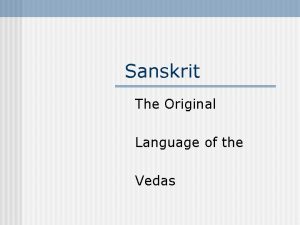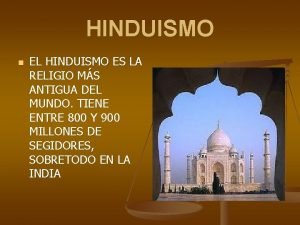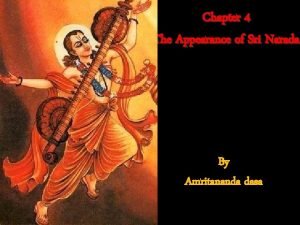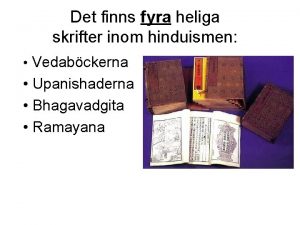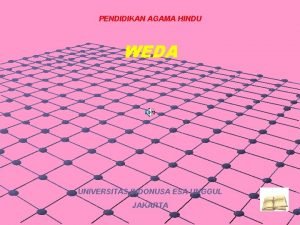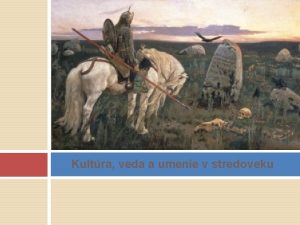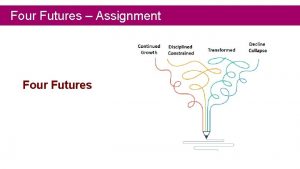The Vedas There are four Vedas Rg Veda






















- Slides: 22

The Vedas There are four Vedas: Rg Veda Yajur Veda Sama Veda Atharva Veda

Each Veda has four parts n n n Hymnal portion (mantras) Ritual portion (brahmanas) Forest teachings (aranyakas) Philosophical portion (upanishads) They were composed around 1500 B. C.

The Rg Veda n n n This Veda contains about 1000 hymns or mantras. At first glance, they appear to be poems in praise of personified natural forces. For example, Indra is the “god” of thunder and rain. Agni is the “god” of fire. Usha is the “godess” of dawn. Prithvi is the “goddess” of earth.

The first verse of the Rg Veda n Agnimile purohitam yajnasya devam rtvijam hotaram ratna dhatamam. I adore the Fire, the sacrificial priest, luminous vibrations of Truth, the fierce warrior, the bestower of delight.

Agni n n n The Sanskrit word agni and the Latin word ignis both mean “fire”. Agnimile can be translated as “I adore the Fire”. The word purohita is a combination two words, pur and hitam. pur originally meant “door”, or “gate” and later came to mean “house” or “city”. hitam is an adjective referring to that which has been put before, or placed before.

purohitam n n This word indicates that “fire” has been placed before us, implying that there is something beyond the “fire”. Fire as a sacrificial priest must be taken as an intermediary between us and something deeper.

yajna = sacrifice n n This is a word that recurs in later Upanishads and the Bhagavadgita. yajna is derived from yaj which refers to the act of applying oneself quietly and persistently to master an art or a science through focused attention. So what fire is being referred to? It is the “fire of enthusiasm”.

Deva n n n This word is usually translated as “god”. The literal meaning is “a shining one”. deva is derived from div which means “to flash” or “to gleam” , “to vibrate”, “to sparkle. ” It later came to mean a “god” or more precisely, “one who plays with light. ” The Latin word divus and the English word divine are derived from deva. dios in Spanish and dieu in French also can be traced back to deva.

rtam = cosmic order n n rtvijam is a combination of rtam and vijam. vij means “to vibrate”, “to be full of ecstatic energy. ” The Latin word vigere meaning “to be strong” and the English word vigor are derived from the Sanskrit root, vij. Thus, Fire is a luminous vibration of cosmic order.

hotaram n n The root here is hu meaning “to attack”, “to slay”, as in a battle. Fire is compared to a warrior. Who is the warrior battling with? The fire of enthusiasm slays the demon of lethargy.

ratnadhatamam n n We can break this into ratna and dhatamam. ratna means “jewel” or more precisely, “that which shines” or “that which delights. ” dhatamam is derived from dha meaning “to bestow, ” “to give” or “to create. ” Thus, the fire of enthusiasm is the bestower of delight.

The meaning of the first verse of the Rg Veda n n We invoke the fire of enthusiasm, the gateway to higher knowledge, the slayer of the demon of lethargy and the bestower of delight. The notion of tapas or discipline is derived from this viewpoint and is a dominant theme of the Upanishads. The mind must rise from a lower level to a higher level through tapas literally means “to heat” invoking again the image of agni or fire.

Verse 1. 5 of the Yajur Veda n n n Agne vrata pate vratam charishyami tachakeyam tanme Radhytam idamaham nruta satyamupaimi May Agni, the fire of our vows, inspire me to master my lower self. May the fire grant me strength and make my effort fruitful.

Indra n n n Indra is said to be “the god of thunder”. However, the meaning becomes clear when we understand that indra is that which controls the indriyas, which signify the sense organs. Thus, Indra really refers to the power of the mind. The thunderbolt, is the nerve impulse.

Usha, Vak and Vayu n n Usha represents the dawn. Dawn is an intermediary, the ushering of light. Vak represents the power of speech. The Latin vox or the English voice are derived from vak. Vayu is said to be “the god of wind” but when we analyze the hymns, we see that it signifies “the life principle. ” Later, prana and even atman are used in the later Upanishads to signify “the life principle”.

Hymn 164 of the Rg Veda n n Indram mitram varunam agni mahuradho divyah Sa suparno garutman Ekam sat vipra bahudha vadanti They call it Indra, Mitra, Varuna, Agni as well as Garutman of heavenly plumage. That which exists is One, sages call it by various names.

Hymn 10. 129 of the Rg Veda: The Hymn of Creation Neither non-being nor being was as yet, Neither was airy space nor the sky beyond; What was enveloped? And where? And sheltered by whom? And was there water? Bottomless, unfathomed? Death did not exist nor life immortal, Nor was there any sign then of night or day, By its inherent force the One breathed windless, Beyond that, indeed, nothing, whatever was. Darkness was there first hidden by darkness, Undifferentiated surge was this whole world. That which, becoming, by the void was covered, That One by force of heat came into being. In the Principle, thereupon, arose desire, Which of consciousness was the primeval seed. Then the wise, searching within their hearts, Perceived that in non-being lay the bond of being. Their ray extended light across darkness. Was there a below? And was there an above? There were sowers of seeds and forces of might: Potency from beneath and from on high the Will. Who really knows, who could here proclaim, Whence this creation flows, where is its origin? The gods were born after this world’s creation. Who therefore knows from where it has arisen? This flow of creation, from where did it rise? Whether it was ordered, or whether it was not. The Observer, in the highest heaven. That alone knows, or perhaps, … knows it not.

Tad ekam n n n Tad ekam means “That One”. No further elaboration is given. In the third verse, tapas appears and here it literally means “heat”. The last three verses begin a questioning of what is meant by “knowledge” or “knowing”. It signals that “to know something” is perhaps at a lower stage of awareness.

Hymn 8. 58. 2 of the Rg Veda n n n Eka evagnir bahudha samiddha Ekah suryo visvam anu prabhutah Ekaivosah sarvam idam vibhaty Ekam vaidam vi babhuva sarvam “One fire burns in many ways; one sun illumines the world; one dawn dispels the darkness of night; All that exists is One and It has taken all these various forms. ”

Gayatri Mantra (Rg Veda 3. 62. 10) n n n Tat savitur varenyam bhargo devasya dhimahi Dhiyo yo nah prachodayat Let us meditate on the glory of that Supreme that illumines everything. May That illumine our understanding.

Unity hymn (Rg Veda 10. 191. 3) n n Samano mantrah samiti samani Samanam manah saha cittamesam “Common be your prayers. Common be the end of your assembly. Common be your purpose. Common be your deliberations. ” The English word “same” is derived from the Sanskrit samah which means “even, level, similar, identical”.

The Secret of the Veda Hymns to the Mystic Fire n Volumes 10 and 11 of the Collected Works of Sri Aurobindo.
 Antigentest åre
Antigentest åre Qué significa las vedas
Qué significa las vedas Atharva veda mantras
Atharva veda mantras What is the original language of the vedas
What is the original language of the vedas Religioms
Religioms Sri narada
Sri narada Znaky výchovy
Znaky výchovy Peygamber efendimizin veda hutbesi
Peygamber efendimizin veda hutbesi Veda hutbes
Veda hutbes Naravoslovna veda
Naravoslovna veda Veda hutbesi maddeleri
Veda hutbesi maddeleri Svetasvatara upanishad chapter 6 verse 9
Svetasvatara upanishad chapter 6 verse 9 Veda johnson
Veda johnson Veda skrifter
Veda skrifter Kultura a věda mezi válkami
Kultura a věda mezi válkami Visi keliai veda i roma posakis
Visi keliai veda i roma posakis Nezkreslená věda polovodiče
Nezkreslená věda polovodiče Bionika
Bionika Yang termasuk vedangga/batang tubuh veda adalah
Yang termasuk vedangga/batang tubuh veda adalah Dede korkut'un torunu
Dede korkut'un torunu Aruza veda hangi ölçüyle yazılmıştır
Aruza veda hangi ölçüyle yazılmıştır Veda ktora sa zaobera krasovymi procesmi
Veda ktora sa zaobera krasovymi procesmi Gotický sloh
Gotický sloh



